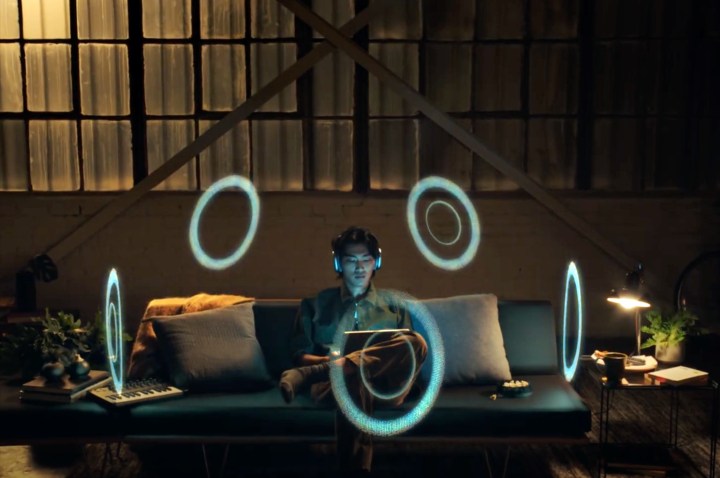With the release of the tvOS 15 beta last week, we finally got our first taste of what Apple’s spatial audio sounds like when you combine an Apple TV 4K with a big-screen TV and the head-tracking built into the company’s AirPods Max or AirPods Pro. The result? A virtual home theater experience that will put a 65-inch smile on your face.
Apple launched spatial audio on the AirPods Pro in 2020. At the time, it made use of head-tracking technology to create a highly convincing 3D effect that turned your iPhone or iPad’s screen into a virtual movie theater. If you held your iPhone in front of you and moved your head from side to side, dialogue and other key soundtrack elements stayed pinned to the iPhone’s location. Turning your head to the right meant that these sounds seemed to still be coming from your phone.

With the release of tvOS 15, that same trick now works on an Apple TV 4K, on the biggest screen in the house. Does Apple’s virtual surround sound effect work as well when watching a 55-inch or larger screen? In a word: Yes.
Using a set of AirPods Max (it also works with AirPods Pro) and a second-gen Apple TV 4K, I fired up a variety of movies on Apple TV+, Disney+, Amazon Prime Video, and Netflix. Apple says the feature will work with Dolby 5.1 but you should get the best experience from Dolby Atmos content. Starting with Avengers: Endgame on Disney+, I was immediately taken by how real spatial audio sounds.
Surround sound in your head
What I mean is that, if you’ve got a 5.1 or better home theater setup, you’re used to hearing sounds coming from the different speakers — that’s what makes surround sound what it is. Head-tracking spatial audio manages to replicate that sensation using just two small speakers attached to your head. It’s so convincing, I had to keep taking the AirPods Max off to check if the sound was also being piped through my regular speakers.
But it’s not just sound direction that gets preserved; spatial audio also does an admirable job of creating a sense of distance to the sound source. This is where spatial on the big screen outdoes spatial on a phone or tablet. When using spatial audio on an iPhone, you get the same immersive effects, but because you’re holding a small screen in your hand — often only inches away — your brain senses a mismatch between the size of the image and the size/distance of the sound you’re hearing.
When using an Apple TV 4K with a big TV, that mismatch is resolved and your brain is handily fooled into thinking the sound is coming from its normal locations around the room.
Not a perfect substitute
It’s not a perfect substitute for conventional speakers. It’s hard to replicate the feel-it-in-your-chest bass of a subwoofer, and Dolby Atmos height channel sounds (the classic helicopter flying overhead effect) aren’t quite as thrilling. But on the other hand, dialogue is easier to understand and you get to benefit from Apple’s outstanding active noise cancellation on the AirPods Max and Pro.
If you live in a condo with thin walls, or you like to do most of your movie watching when the rest of the house is asleep, I can’t recommend spatial audio for Apple TV 4K enough. For $729 or less ($180 for the Apple TV 4K, $549 for AirPods Max), you’ve got a private listening experience that comes incredibly close to rivaling a sound system that can cost thousands.
At the moment, head-tracking spatial audio requires:
- Apple TV 4K (gen 1 or gen 2)
- tvOS 15 beta or higher
- AirPods Pro or AirPods Max
- Dolby 5.1 or Dolby Atmos content from:
- Apple TV+
- Disney+
- Amazon Prime Video
What about Netflix?
Netflix will also likely benefit from spatial audio, but right now tvOS 15 beta does something odd with Netflix content. Regardless of whether your chosen movie is presented in 5.1 or Dolby Atmos, it gets down-converted to two-channel stereo when listening via AirPods. The Apple TV control center will indicate that spatial audio is available, but turning it on and off doesn’t seem to make a noticeable difference, and there is no relative change in audio direction when you turn your head.
Wondering about Dolby Atmos Music from Apple Music? Apple has said it plans to add head-tracking spatial audio to this content, too, but that doesn’t arrive until this fall. My experience with Apple’s spatial audio treatment of Dolby Atmos Music has been a bit hit-and-miss, so I’m anxious to see if the addition of head-tracking does as much for immersive music as it does for immersive movie soundtracks.



